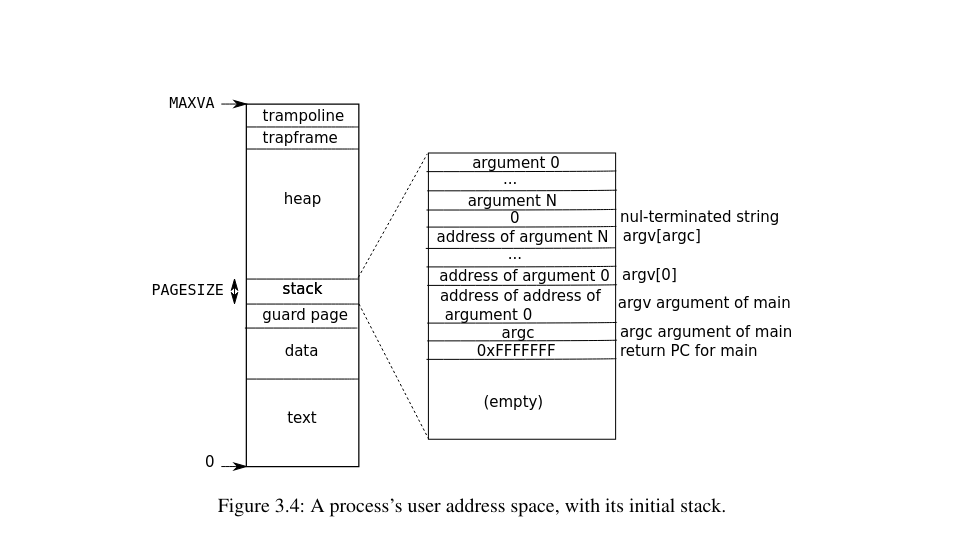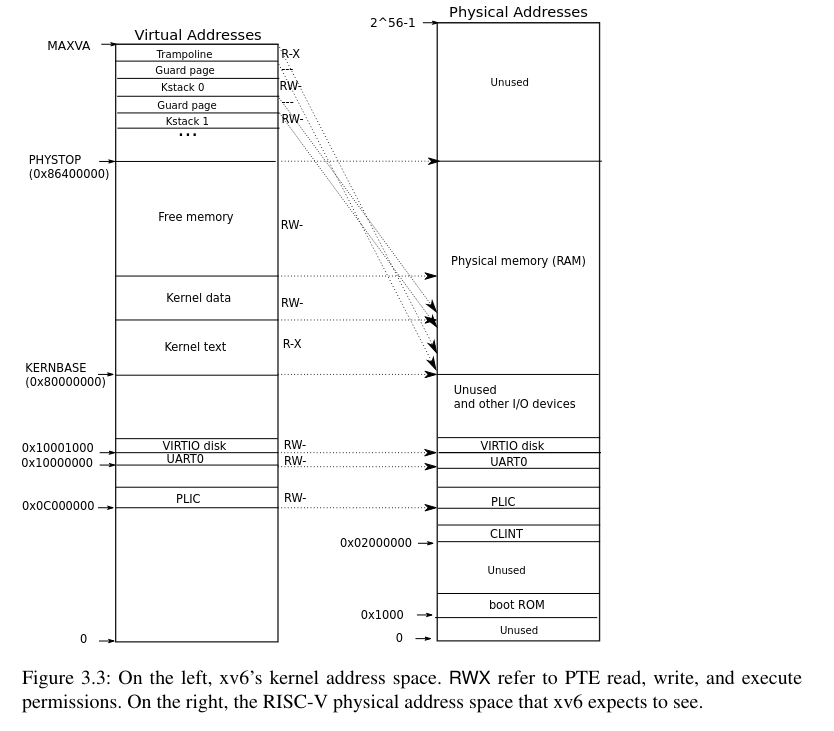Memory Layout
Most of the code is in memlayout.h.
Trapping
After a trap, the kernel calls uservec, usertrap, usertrapret,
userret
uservecsaves user mode registers for later, and loads kernel registers. It then switches to the kernel’s address space by modifyingsatp.usertraphandles the trap itselfusertrapretthen restoressatp, to swap back to the user’s address space, and thesretinstruction restores the user mode program counter and enables interrupts.
Trampoline and Trap Frames

Each user process contains the following:
- program code
- data
- the stack
- heap
With two special pages:
-
The trampoline page
- shared amongst all user processes
- contains
uservecanduserretfunctions - mapped as read-only and accessible for the supervisor
-
Trap frame page
- unique per process
- stores user registers during a trap
- mapped as read-write but inaccessible in user mode.
The kernel also includes the trampoline page at its top.
Kernel Virtual Address Space & Physical Memory

The kernel’s memory layout starts at 0.
- Devices are mapped to specific addresses before 2GB.
- Physical RAM at 2GB, with up to 128MB.
- Kernel code and data are stored in lower physical memory.
Kernel Virtual Address Space:
- The kernel’s virtual address space is directly mapped to physical memory.
- Devices are also directly mapped
Each of the 64 user processes have a dedicated kernel stack page. With some guard pages, which are unmapped to prevent stack overflows.
Memlayout.h
Memlayout.h contains memory layout constants:
-
Devices are mapped at a constant location
-
Hardware registers are mapped at specific addresses
-
KERNBASEis the kernel load address (2GB) -
PHYSTOPis 2GB + 128MB, the end of physical memory -
TRAMPOLINEis the address of the trampoline page -
TRAPFRAMEis the address of the trap frame page
// 00001000 -- boot ROM, provided by qemu
// 02000000 -- CLINT
// 0C000000 -- PLIC
// 10000000 -- uart0
// 10001000 -- virtio disk
// 80000000 -- boot ROM jumps here in machine mode
// -kernel loads the kernel here
// unused RAM after 80000000.
// the kernel uses physical memory thus:
// 80000000 -- entry.S, then kernel text and data
// end -- start of kernel page allocation area
// PHYSTOP -- end RAM used by the kernel
// qemu puts UART registers here in physical memory.
#define UART0 0x10000000L
#define UART0_IRQ 10
// virtio mmio interface
#define VIRTIO0 0x10001000
#define VIRTIO0_IRQ 1
// qemu puts platform-level interrupt controller (PLIC) here.
#define PLIC 0x0c000000L
#define PLIC_PRIORITY (PLIC + 0x0)
#define PLIC_PENDING (PLIC + 0x1000)
#define PLIC_SENABLE(hart) (PLIC + 0x2080 + (hart)*0x100)
#define PLIC_SPRIORITY(hart) (PLIC + 0x201000 + (hart)*0x2000)
#define PLIC_SCLAIM(hart) (PLIC + 0x201004 + (hart)*0x2000)
// the kernel expects there to be RAM
// for use by the kernel and user pages
// from physical address 0x80000000 to PHYSTOP.
#define KERNBASE 0x80000000L
#define PHYSTOP (KERNBASE + 128*1024*1024)
// map the trampoline page to the highest address,
// in both user and kernel space.
#define TRAMPOLINE (MAXVA - PGSIZE)
// map kernel stacks beneath the trampoline,
// each surrounded by invalid guard pages.
#define KSTACK(p) (TRAMPOLINE - ((p)+1)* 2*PGSIZE)
// User memory layout.
// Address zero first:
// text
// original data and bss
// fixed-size stack
// expandable heap
// ...
// TRAPFRAME (p->trapframe, used by the trampoline)
// TRAMPOLINE (the same page as in the kernel)
#define TRAPFRAME (TRAMPOLINE - PGSIZE)